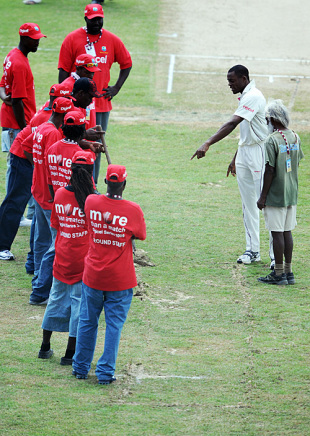Dousing the euphoria
Yesterday's fiasco presented the latest, most dramatic explanation for the sudden decline of West Indies cricket
14-Feb-2009

| ||
Yesterday's fiasco presented the latest, most dramatic explanation for the sudden decline of West Indies cricket, from its unprecedented excellence of the 1980s to the mediocrity of the past two decades. It was yet another example of the politics and the mismanagement that has undermined a game that once elevated this small, impoverished and otherwise insignificant part of the world from third to first world status.
Its timing is most inopportune, coming immediately after the West Indies' most significant victory in years. The passionate public, so disenchanted with prolonged failure, was energised again by the result in the first Test and, more especially, the manner of it.
In less than a week, the euphoria of Sabina Park has been doused. It should not have come to this. There had been repeated problems with the outfield at the Sir Vivian Richards Stadium since it was one of the expensive new stadiums constructed around the Caribbean for the 2007 World Cup.
It was sited, against repeated advice from locals, in a basin near a well-known water course. As everywhere else, an elaborate draining system was installed yet, as forecast, water from overnight rain collected on parts of the outfield and disrupted two matches. It meant remedial work had to be done on the offending areas.
Without any trial, a Test against Australia was again assigned to the ground last season. Once more, parts of the outfield became a bog, and almost a full day's play was lost, all told in a drawn match, in spite of hot, sunny weather.
The warning signals were not heeded by the West Indies Cricket Board (WICB). Politics kicked in and it assigned the England Test on the say-so of the government-appointed stadium committee, the Antigua Cricket Association and, ultimately, the Leeward Islands Cricket Association (LICA), the WICB's relevant member board, that all would be right on the day.
As usual, the buck for this embarrassment will be passed around, but there is only one place for it to stop, at the WICB headquarters just a few miles down the road towards St John's, and the Antigua Recreation Ground (ARG) which will now be reactivated to ease the shame.
A similar situation has developed in Barbados, where the demarcation lines between government-appointed Kensington Oval Management Inc (KOMI) and the Barbados Cricket Association (BCA) over who controls the ground, and when, is still not properly resolved.
The staging of one of the main shows during last year's Kadooment festival so damaged the square that none of this season's regional first-class matches could be played on it while work to restore the grass was carried out in readiness for February 26, the start of the third Test. Fortunately, Richard "Prof" Edwards, who was recalled to oversee the operation, reports that it would be ready for a Test even this weekend. But it has exposed the potential danger of shared responsibility.
The job at the Sir Vivian Richards Stadium was more extensive than Kensington's. It covered the entire outfield but the WICB apparently didn't think it necessary to monitor just what was planned. It knew it involved tonnes and tonnes of sand, a commodity readily available from Antigua's famed 365 beaches, one for every day of the year. What it didn't bother to check was whether the beach for the leap year would be located on the outfield.
Those who turned up at the ground a few days ago immediately recognised that these were not suitable conditions for Test cricket. Several were willing to wager sizeable sums that it would be quickly abandoned, but they could get no takers from those wary, if not quite as confident.
It was the same in Kingston in 1998 when Tony Howard, then Barbados team manager, now, coincidently, a WICB operative, reported after a preceding inter-island match that the pitch at Sabina Park was too dangerous for Test cricket. It took only 10.1 overs to justify his concern.
Such laxity can be traced, almost directly, to the fact that West Indies cricket is now basically in the hands of those with little background in the game. It is no coincidence that during the days of dominance, there were only three WICB presidents- Jeffrey Stollmeyer, Allan Rae and Clyde Walcott, all outstanding Test players in their time. Steve Camacho, another former Test player, served as chief executive for 18 years.
In the past 20 years, Wes Hall has been the only Test player among five presidents. There have been six chief executives since Camacho. None was known even as a reputable club cricketer. Camacho is resident in Antigua. He was among those worried over the state of the outfield. It would hardly have reached such a sorry pass under his watch.
Instead, West Indies cricket is again acutely embarrassed by administrative bungling. No one has more reason to be incensed than the revered Antiguan, after whom the stadium is named.
Tony Cozier has written about and commentated on cricket in the Caribbean for nearly 50 years